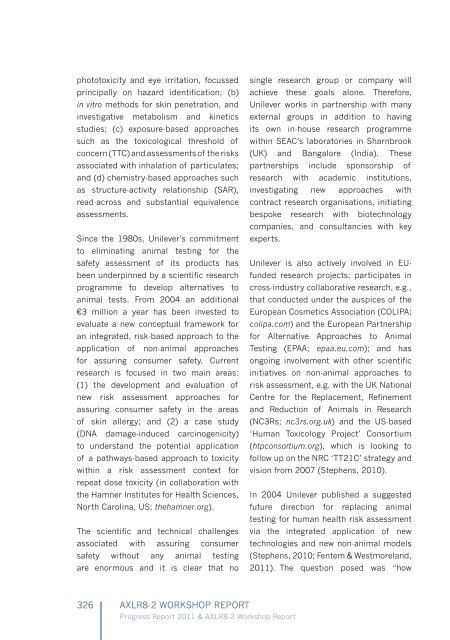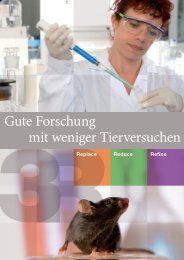You also want an ePaper? Increase the reach of your titles
YUMPU automatically turns print PDFs into web optimized ePapers that Google loves.
phototoxicity and eye irritation, focussed<br />
principally on hazard identification; (b)<br />
in vitro methods for skin penetration, and<br />
investigative metabolism and kinetics<br />
studies; (c) exposure-based approaches<br />
such as the toxicological threshold of<br />
concern (TTC) and assessments of the risks<br />
associated with inhalation of particulates;<br />
and (d) chemistry-based approaches such<br />
as structure-activity relationship (SAR),<br />
read-across and substantial equivalence<br />
assessments.<br />
Since the 1980s, Unilever’s commitment<br />
to eliminating animal testing for the<br />
safety assessment of its products has<br />
been underpinned by a scientific research<br />
programme to develop alternatives to<br />
animal tests. From 2004 an additional<br />
€3 million a year has been invested to<br />
evaluate a new conceptual framework for<br />
an integrated, risk-based approach to the<br />
application of non-animal approaches<br />
for assuring consumer safety. Current<br />
research is focused in two main areas:<br />
(1) the development and evaluation of<br />
new risk assessment approaches for<br />
assuring consumer safety in the areas<br />
of skin allergy; and (2) a case study<br />
(DNA damage-induced carcinogenicity)<br />
to understand the potential application<br />
of a pathways-based approach to toxicity<br />
within a risk assessment context for<br />
repeat dose toxicity (in collaboration with<br />
the Hamner Institutes for Health Sciences,<br />
North Carolina, US; thehamner.org).<br />
The scientific and technical challenges<br />
associated with assuring consumer<br />
safety without any animal testing<br />
are enormous and it is clear that no<br />
single research group or company will<br />
achieve these goals alone. Therefore,<br />
Unilever works in partnership with many<br />
external groups in addition to having<br />
its own in-house research programme<br />
within SEAC’s laboratories in Sharnbrook<br />
(UK) and Bangalore (India). These<br />
partnerships include sponsorship of<br />
research with academic institutions,<br />
investigating new approaches with<br />
contract research organisations, initiating<br />
bespoke research with biotechnology<br />
companies, and consultancies with key<br />
experts.<br />
Unilever is also actively involved in EUfunded<br />
research projects; participates in<br />
cross-industry collaborative research, e.g.,<br />
that conducted under the auspices of the<br />
European Cosmetics Association (COLIPA;<br />
colipa.com) and the European Partnership<br />
for Alternative Approaches to Animal<br />
Testing (EPAA; epaa.eu.com); and has<br />
ongoing involvement with other scientific<br />
initiatives on non-animal approaches to<br />
risk assessment, e.g. with the UK National<br />
Centre for the Replacement, Refinement<br />
and Reduction of Animals in Research<br />
(NC<strong>3R</strong>s; nc3rs.org.uk) and the US-based<br />
‘Human Toxicology Project’ Consortium<br />
(htpconsortium.org), which is looking to<br />
follow up on the NRC ‘TT21C’ strategy and<br />
vision from 2007 (Stephens, 2010).<br />
In 2004 Unilever published a suggested<br />
future direction for replacing animal<br />
testing for human health risk assessment<br />
via the integrated application of new<br />
technologies and new non-animal models<br />
(Stephens, 2010; Fentem & Westmoreland,<br />
2011). The question posed was “how<br />
326 AXLR8-2 WORKSHOP REPORT<br />
Progress Report 2011 & AXLR8-2 Workshop Report




